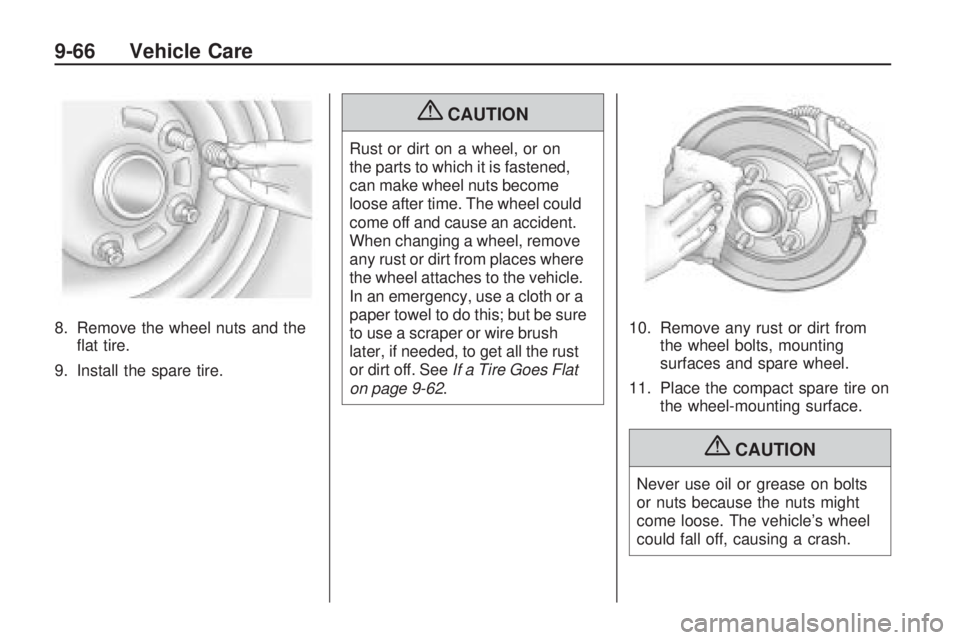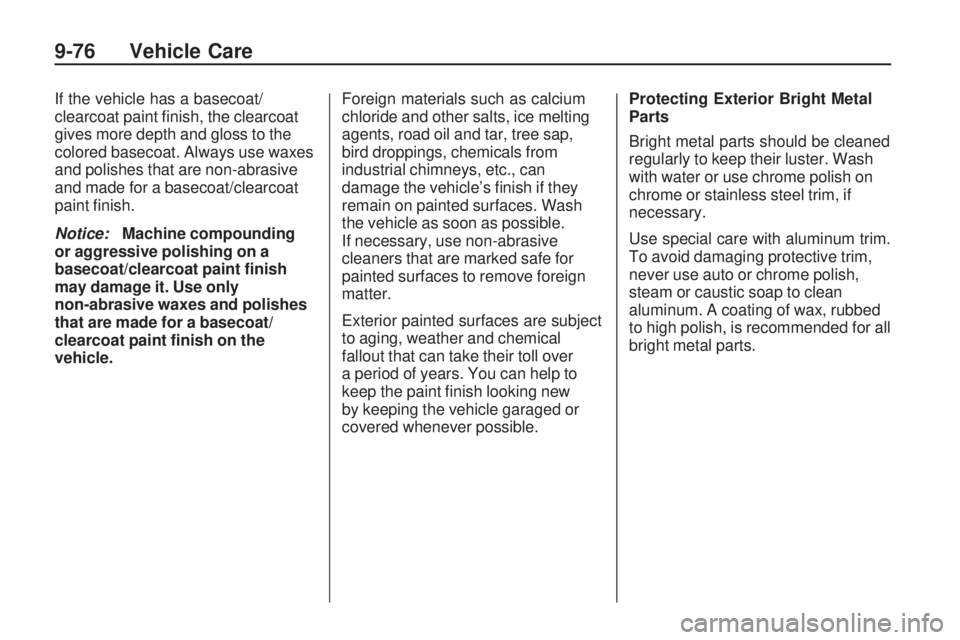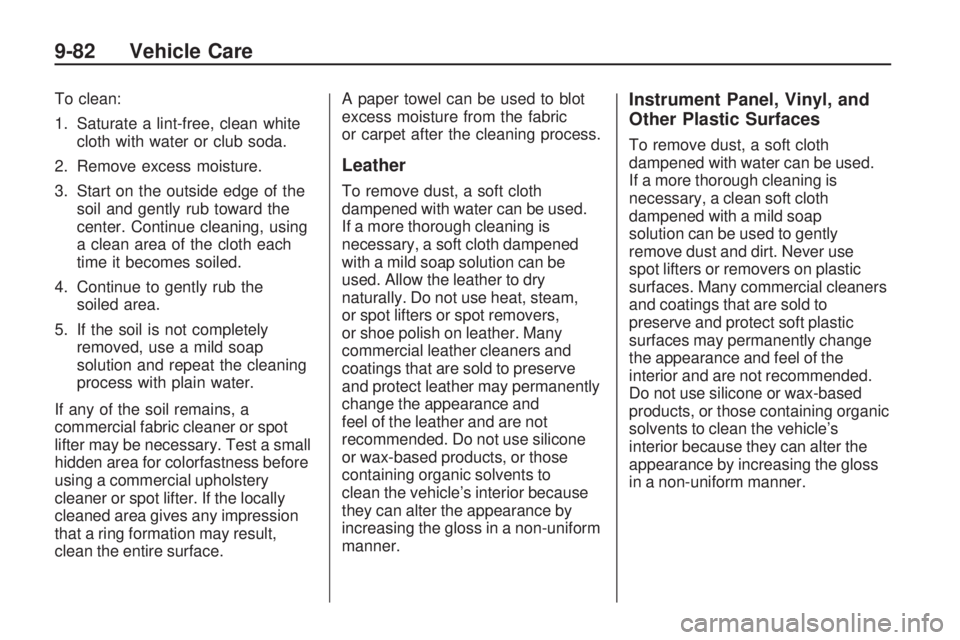2010 PONTIAC VIBE oil
[x] Cancel search: oilPage 205 of 318

How to Add Coolant to the
Coolant Recovery Tank
If you need more coolant, add the
proper DEX-COOL®coolant mixture
at the coolant recovery tank, but
be careful not to spill it.
Occasionally check the coolant level
in the radiator. For information on
how to add coolant to the radiator,
see Cooling System on page 9-19 .
{CAUTION
You can be burned if you spill
coolant on hot engine parts.
Coolant contains ethylene glycol,
and it will burn if the engine parts
are hot enough. Do not spill
coolant on a hot engine.
{CAUTION
Adding only plain water to your
cooling system can be dangerous.
Plain water, or some other liquid
such as alcohol, can boil before
the proper coolant mixture will.
(Continued)
CAUTION (Continued)
Your vehicle’s coolant warning
system is set for the proper
coolant mixture. With plain water
or the wrong mixture, your engine
could get too hot but you would
not get the overheat warning.
Your engine could catch fire and
you or others could be burned.
Use a 50/50 mixture of clean,
drinkable water and a proper
coolant.
Notice: In cold weather, water
can freeze and crack the engine,
radiator, heater core and other
parts. Use the recommended
coolant and the proper coolant
mixture.
Vehicle Care 9-21
Page 207 of 318

5. Put the cap back on the coolantrecovery tank, but leave the
pressure cap off.
6. Start the engine and let it run until you can feel the upper
radiator hose getting hot. Watch
out for the engine cooling fan.
7. By this time, the coolant level inside the radiator filler neck may
be lower. If the level is lower,
add more of the proper coolant
mixture through the filler neck
until the level reaches the base
of the filler neck.
8. Then replace the pressure cap. At any time during this procedure
if coolant begins to flow out of the
filler neck, reinstall the pressure
cap. Be sure the ears on the
pressure cap are in line with
the vent tube.Engine Overheating
A coolant temperature gage is
located on the vehicle’s instrument
panel. See Engine Coolant
Temperature Gage on page 4-11 .
Check to see if the electric engine
cooling fan is running. If the engine
is overheating, the fan should be
running. If it is not, the vehicle needs
service.
If no problem is apparent, but the
coolant level is not at or above the
FULL mark, add a 50/50 mixture
of clean, drinkable water and
DEX-COOL
®coolant at the coolant
recovery tank. See Engine Coolant
on page 9-19 for more information
about the proper coolant mixture.
If the coolant inside the coolant
recovery tank is boiling, do not do
anything else until it cools down.
The vehicle should be parked on
a level surface.
If Steam Is Coming From Your
Engine
{CAUTION
Steam from an overheated engine
can burn you badly, even if you
just open the hood. Stay away
from the engine if you see or hear
steam coming from it. Just turn it
off and get everyone away from
the vehicle until it cools down. Wait
until there is no sign of steam or
coolant before you open the hood.
If you keep driving when your
engine is overheated, the liquids
in it can catch fire. You or others
could be badly burned. Stop your
engine if it overheats, and get
out of the vehicle until the engine
is cool.
Notice: If the engine catches
�re because of being driven with
no coolant, your vehicle can be
badly damaged. The costly repairs
would not be covered by the
vehicle warranty.
Vehicle Care 9-23
Page 212 of 318

What to Add
Use only new DOT-3 brake
fluid from a sealed container.
SeeRecommended Fluids and
Lubricants on page 10-15 .
Always clean the brake fluid
reservoir cap and the area around
the cap before removing it. This
helps keep dirt from entering the
reservoir.
{CAUTION
With the wrong kind of fluid in the
brake or clutch hydraulic system,
the brakes or clutch might not
work well. This could cause a
crash. Always use the proper
brake fluid. Notice:
Using the wrong �uid can
badly damage brake or clutch
hydraulic system parts.
For example, just a few drops
of mineral-based oil, such as
engine oil, in the brake or clutch
hydraulic system can damage
brake or clutch hydraulic
system parts so badly that they
will have to be replaced. Do not
let someone put in the wrong
kind of �uid.
If brake �uid is spilled on the
vehicle’s painted surfaces, the
paint �nish can be damaged.
Be careful not to spill brake
�uid on the vehicle. If you do,
wash it off immediately.
Battery
This vehicle has a maintenance
free battery. When it is time for a
new battery, see your dealer/retailer
for one that has the replacement
number shown on the original
battery’s label. See
Engine
Compartment Overview on
page 9-6 for battery location.
{WARNING
Battery posts, terminals, and
related accessories contain lead
and lead compounds, chemicals
known to the State of California
to cause cancer and reproductive
harm. Wash hands after handling.
9-28 Vehicle Care
Page 231 of 318

Bead:The tire bead contains
steel wires wrapped by steel
cords that hold the tire onto
the rim.
Bias Ply Tire
:A pneumatic
tire in which the plies are laid
at alternate angles less than
90 degrees to the centerline
of the tread.
Cold Tire Pressure
:The
amount of air pressure in a tire,
measured in pounds per square
inch (psi) or kilopascals (kPa)
before a tire has built up heat
from driving. See Tire Pressure
on page 9-49.
Curb Weight
:The weight of
a motor vehicle with standard
and optional equipment including
the maximum capacity of fuel,
oil, and coolant, but without
passengers and cargo. DOT Markings
:A code
molded into the sidewall of a
tire signifying that the tire is
in compliance with the U.S.
Department of Transportation
(DOT) motor vehicle safety
standards. The DOT code
includes the Tire Identification
Number (TIN), an alphanumeric
designator which can also
identify the tire manufacturer,
production plant, brand, and
date of production.
GVWR
:Gross Vehicle Weight
Rating. See Vehicle Load
Limits on page 8-12.
GAWR FRT
:Gross Axle
Weight Rating for the front axle.
See Vehicle Load Limits on
page 8-12.
GAWR RR
:Gross Axle
Weight Rating for the rear axle.
See Vehicle Load Limits on
page 8-12. Intended Outboard Sidewall
:The side of an asymmetrical tire,
that must always face outward
when mounted on a vehicle.
Kilopascal (kPa)
:The metric
unit for air pressure.
Light Truck (LT-Metric) Tire
:A tire used on light duty
trucks and some multipurpose
passenger vehicles.
Load Index
:An assigned
number ranging from 1 to 279
that corresponds to the load
carrying capacity of a tire.
Maximum In�ation Pressure
:The maximum air pressure to
which a cold tire can be inflated.
The maximum air pressure is
molded onto the sidewall.
Maximum Load Rating
:The load rating for a tire at the
maximum permissible inflation
pressure for that tire.
Vehicle Care 9-47
Page 250 of 318

8. Remove the wheel nuts and theflat tire.
9. Install the spare tire.
{CAUTION
Rust or dirt on a wheel, or on
the parts to which it is fastened,
can make wheel nuts become
loose after time. The wheel could
come off and cause an accident.
When changing a wheel, remove
any rust or dirt from places where
the wheel attaches to the vehicle.
In an emergency, use a cloth or a
paper towel to do this; but be sure
to use a scraper or wire brush
later, if needed, to get all the rust
or dirt off. See If a Tire Goes Flat
on page 9-62. 10. Remove any rust or dirt from
the wheel bolts, mounting
surfaces and spare wheel.
11. Place the compact spare tire on the wheel-mounting surface.
{CAUTION
Never use oil or grease on bolts
or nuts because the nuts might
come loose. The vehicle’s wheel
could fall off, causing a crash.
9-66 Vehicle Care
Page 260 of 318

If the vehicle has a basecoat/
clearcoat paint finish, the clearcoat
gives more depth and gloss to the
colored basecoat. Always use waxes
and polishes that are non-abrasive
and made for a basecoat/clearcoat
paint finish.
Notice:Machine compounding
or aggressive polishing on a
basecoat/clearcoat paint �nish
may damage it. Use only
non-abrasive waxes and polishes
that are made for a basecoat/
clearcoat paint �nish on the
vehicle. Foreign materials such as calcium
chloride and other salts, ice melting
agents, road oil and tar, tree sap,
bird droppings, chemicals from
industrial chimneys, etc., can
damage the vehicle’s finish if they
remain on painted surfaces. Wash
the vehicle as soon as possible.
If necessary, use non-abrasive
cleaners that are marked safe for
painted surfaces to remove foreign
matter.
Exterior painted surfaces are subject
to aging, weather and chemical
fallout that can take their toll over
a period of years. You can help to
keep the paint finish looking new
by keeping the vehicle garaged or
covered whenever possible.Protecting Exterior Bright Metal
Parts
Bright metal parts should be cleaned
regularly to keep their luster. Wash
with water or use chrome polish on
chrome or stainless steel trim, if
necessary.
Use special care with aluminum trim.
To avoid damaging protective trim,
never use auto or chrome polish,
steam or caustic soap to clean
aluminum. A coating of wax, rubbed
to high polish, is recommended for all
bright metal parts.
9-76 Vehicle Care
Page 265 of 318

Cleaners can contain solvents that
can become concentrated in the
vehicle’s interior. Before using
cleaners, read and adhere to all
safety instructions on the label.
While cleaning the vehicle’s interior,
maintain adequate ventilation by
opening the vehicle’s doors and
windows.
Do not clean the interior using the
following cleaners or techniques:
•Never use a knife or any
other sharp object to remove a
soil from any interior surface.
•Never use a stiff brush. It can
cause damage to the vehicle’s
interior surfaces.
•Never apply heavy pressure or
rub aggressively with a cleaning
cloth. Use of heavy pressure can
damage the interior and does not
improve the effectiveness of soil
removal.
•Use only mild, neutral-pH soaps.
Avoid laundry detergents
or dishwashing soaps with
degreasers. Using too much
soap will leave a residue that
leaves streaks and attracts dirt.
For liquid cleaners, about
20 drops per gallon (3.78 L)
of water is a good guide.
•Do not heavily saturate the
upholstery while cleaning.
•Damage to the vehicle’s interior
may result from the use of many
organic solvents such as naptha,
alcohol, etc.
Fabric/Carpet
Use a vacuum cleaner with a soft
brush attachment to remove dust
and loose dirt. A canister vacuum
with a beater bar in the nozzle may
only be used on floor carpet and
carpeted floor mats. For soils, always
try to remove them first with plain
water or club soda. Before cleaning,
gently remove as much of the soil as
possible using one of the following
techniques:
•For liquids: gently blot the
remaining soil with a paper towel.
Allow the soil to absorb into the
paper towel until no more can be
removed.
•For solid dry soils: remove as
much as possible and then
vacuum.
Vehicle Care 9-81
Page 266 of 318

To clean:
1. Saturate a lint-free, clean whitecloth with water or club soda.
2. Remove excess moisture.
3. Start on the outside edge of the soil and gently rub toward the
center. Continue cleaning, using
a clean area of the cloth each
time it becomes soiled.
4. Continue to gently rub the soiled area.
5. If the soil is not completely removed, use a mild soap
solution and repeat the cleaning
process with plain water.
If any of the soil remains, a
commercial fabric cleaner or spot
lifter may be necessary. Test a small
hidden area for colorfastness before
using a commercial upholstery
cleaner or spot lifter. If the locally
cleaned area gives any impression
that a ring formation may result,
clean the entire surface. A paper towel can be used to blot
excess moisture from the fabric
or carpet after the cleaning process.
Leather
To remove dust, a soft cloth
dampened with water can be used.
If a more thorough cleaning is
necessary, a soft cloth dampened
with a mild soap solution can be
used. Allow the leather to dry
naturally. Do not use heat, steam,
or spot lifters or spot removers,
or shoe polish on leather. Many
commercial leather cleaners and
coatings that are sold to preserve
and protect leather may permanently
change the appearance and
feel of the leather and are not
recommended. Do not use silicone
or wax-based products, or those
containing organic solvents to
clean the vehicle’s interior because
they can alter the appearance by
increasing the gloss in a non-uniform
manner.
Instrument Panel, Vinyl, and
Other Plastic Surfaces
To remove dust, a soft cloth
dampened with water can be used.
If a more thorough cleaning is
necessary, a clean soft cloth
dampened with a mild soap
solution can be used to gently
remove dust and dirt. Never use
spot lifters or removers on plastic
surfaces. Many commercial cleaners
and coatings that are sold to
preserve and protect soft plastic
surfaces may permanently change
the appearance and feel of the
interior and are not recommended.
Do not use silicone or wax-based
products, or those containing organic
solvents to clean the vehicle’s
interior because they can alter the
appearance by increasing the gloss
in a non-uniform manner.
9-82 Vehicle Care